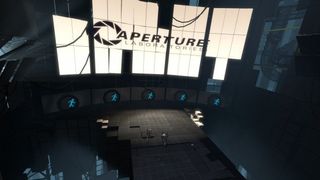Interview: Valve on their insane Portal 2 ideas

I was at Valve last month to interview pretty much everyone I could find, and play one of the most exciting PC games on the horizon: Portal 2. The preview I wrote, and the profile on Valve themselves, is in the new issue of PC Gamer in the UK . But we're also putting up the interviews here on the site, one a day for a week.
Yesterday Gabe and co told us about Valve's failures , and Wednesday's interview was about Valve's big surprises . For today's, I had the brain taxing pleasure of playing Portal 2 in co-op with its project lead Josh Weier, while interviewing both him and writer Erik Wolpaw. I'll explain what's going on in the game any time it's relevant to what they tell me, and I have of course cut out a lot of, "Put one there. No there. No, don't jump in the slime. WHAT'S WRONG WITH YOU?"

PC Gamer: It must be interesting going from a programmer to a project lead, to have an instinctive sense of what's possible and what isn't, whereas if you're just from a design background I guess you have to learn that stuff as you go.
Josh Weier: I think for better or worse I have an engineer's mindset going about things, where I'm breaking down things in the process, and that's actually a really Valve thing to do, anyway. Even our lead designers and artists think that way, it's really a culture thing, which is cool.
As you can see, both you and I are robots. We made that choice because when we started to think about Portal 2 co-op, one of the things that became obvious is that players just want to have fun. There are a lot of ways to drop your buddy in the slime, and do things that would accidentally kill your friend and it was really funny and everybody really enjoyed it. We wanted to play that up, but we didn't want to make that grotesque, because if it were Chell it would be gory, and not that funny.
And there's another aspect to that that we really wanted to hit on that we'll show you in a different map, which was making those deaths more comedic. But also when a player dies, we simply respawn them and the map continues, we didn't want to put in a big penalty for death. We wanted people to be able to make mistakes and have that be a funny thing that you both talk about. Not something where you're like, “Argh, I hate my buddy!” and then punch him. So that was a driving goal for us. I don't have a great way to show you this but-
PC Gamer: What do I look like?
The biggest gaming news, reviews and hardware deals
Keep up to date with the most important stories and the best deals, as picked by the PC Gamer team.
Josh Weier: Ah yes, let's show you that. You can see you look more like a turret, and I look more like one of the little personality spheres. Do you want to talk, Erik, and I can drive?
Erik Wolpaw: Yeah. So, it's Portal, but each of you has a portal gun so each of you can fire a pair of portals. Your two portals are always linked to each other, and your partner's two portals are always linked to each other, but either one of you can go through either of your portals. The portals never get interlinked, so one of my portals will never get linked to one of your portals or vice versa.
(I wave stiffly)
I think you just hit a gesture. There's a whole bunch of context sensitive gestures as well, there'll be more as well go towards shipping. There's some laughing, there's probably some dancing in there.
PC Gamer: I'm so, like, awkward.
Erik Wolpaw: Yeah, one of the things the animators are going for with the gestures is that they're robots trying to imitate human motions. Some of these aren't finished, but the gestures play into the co-op story. The co-op is a completely different track from the single player. It fits into the single player fiction but it's its own little side story.
It's about length. The single player's about six hours, and the co-op is about six hours currently, give or take a little by the time we ship. But these characters appear in the single player game. Once you play the single player game it becomes obvious where this sort of happens, in terms of the single player fiction.
(At the end of the puzzle, Josh and I are ripped apart and sucked into tubes.)
Erik Wolpaw: Oh yeah, that's the... basically at the end of the levels, instead of riding elevators you get disassembled and reassembled. It was one of the reasons we made them robots. In single player death has some consequence. In fiction you die and that's the end of the game. Here, because you have a partner, we need you to be able to come back over and over again, so the robots can be built.
This is an example of a slightly more complicated puzzle here.
(We're in a large room full of slime, lasers and spiky crusher machines.)
Now what Josh is going to do is de-power the crusher, which will bring it down. The lift is going to go down and the one that's over here is going to come up. So what you'll need to do is-
PC Gamer: Jump to the lift without crossing through the beam?
Erik Wolpaw: Ah! But, you can't actually jump that far so you're going to have to think about-
PC Gamer: Portal to the lift!
Erik Wolpaw: Yes, portal it.
Josh Weier: Okay, tell me when you're ready.
PC Gamer: Apparently I'm ready!
Josh Weier: Okay.
PC Gamer: Wait. I'm facing the wrong way.
Erik Wolpaw: Woah. Oh god! No! Wait, no you're okay, just jump, jump, jump!
(I make it, and Josh manipulates the level for me to get to the exit. Once there, I have to manipulate it in turn to clear the way for him to join me.)
GLaDOS: As an impartial facilitator, it would be unfair of me to name my favourite member of your team. However it's perfectly fair to mention it in a way that my least favourite member probably isn't smart enough to understand. Participant Orange, you are doing veeery well.

Erik Wolpaw: She's trying to break you two apart. We have a whole series of puzzles that are asymmetric in that way, where one person has a specific job to do and helps guide the other person through the puzzle, and the other person has more of an execution role. This is another new element. These are laser bridges. What happens is, if you put a portal at one end of the laser bridge, and put another somewhere else, the bridge will extend.
PC Gamer: Oh nice.
Erik Wolpaw: Yeah, so you can navigate through there. We're kind of cherry picking levels in this demo from all over the place. There's no real progression in terms of what you might have been trained on.
One of the things is, in the single player campaign and in Portal 1, there's buttons, and boxes you place on the buttons. In the multiplayer game there's also these balls that go on a different type of button. The big thing about these balls is that they bounce, so it means that you need to get under it or else it's going to bounce off of this thing.
(In the ensuing puzzle, I have to use my portals to extend a light bridge over Josh's head in mid-air, so that a jump pad doesn't knock him into a vapourisation field. After he hits his head on my bridge, I have to quickly move it beneath him so that he also lands on it. In return, he extends the bridge to me with his own portals, I walk over and he passes me the ball he's carrying.)
GLaDOS: The two of you have forged an excellent partnership, with one of you handling the cerebral challenges, and the other ready to ponderously wander into action.
Josh Weier: One of the fun things about co-op is sometimes making mistakes is more fun than getting it right straight away, because you're trying to figure out how to come back.
Erik Wolpaw: Yeah the animators are going crazy with death animations to try and, you know, all the different situations you can die, the goal is for them all to be entertaining.
Right, so this puzzle. In single player, in Portal 1, and in Portal 2 as well, we try not to do a lot of timed puzzles, where there was time pressure. But in the co-op we actually found that it was a lot more fun to do the time stuff with a partner, where you kind of come up with a plan and then execute it, and this is an example of one of those.
Josh Weier: It's funny with co-op, because one thing we discovered really early on is that we could throw really hard problems at players in single player that stump them, and they'd get tired and they'd go off and look online for a solution.
In co-op, there's this really interesting thing where because you're talking to someone, you're talking about your process:
“How do we get to the button?”
“Oh, I don't know. What if we did this and this?”
And just like in real life, communicating that way, you suddenly go, “Oh, it's this!”
So there's a lot of cool moments in co-op where your buddy goes, “Oh I know how to do it, I know how to do it!” And then he gets it wrong. And you're like “Oh I know how to do it I'm gonna do it!”
And so there's this really neat back and forth that occurs with doing that. It gives you those “Aha!” moments in Portal, but it's all the more cool because you've got your buddy there doing it too, and that's really neat.
PC Gamer: There aren't really that many co-op puzzle games, are there?
Josh Weier: Not a bunch.
PC Gamer: It's funny because if I'm in the office and I'm playing a shooter, if someone's looking over my shoulder, they're not saying “hey, throw a grenade there” or “try shooting that”. But whenever there's a puzzle game there'll be a crowd that gathers, and everyone's suggesting stuff.
Erik Wolpaw: That was the thing. Anecdotally, as soon as we shipped Portal, just from people who work here, we kept hearing the same story over and over again, which was “I played it with my son, or my daughter, I played it with my wife or girlfriend and we played it co-operatively.” I mean, right from before any other decision was made about the sequel we knew that was something we wanted to put in, to formalise the co-operative nature of it. Having said that once you bite it off there's all sort of unforseen things like some easy to solve, like, put a portal here, we quickly realised you needed another way to do that. But just other things, wrapping your head around what the puzzle design for four portals is. One of the things is that each puzzle must require four portals to solve. So in other words, if one person can figure out how to solve it with just one set of portals then it's back to the drawing board, so it's a whole different set of design problems with the co-op stuff, which also meant that, whether we wanted to make it a separate track or not, it had to be a separate track because it doesn't work in a single player track, the puzzles are just different.
Josh Weier: I think one of the things that was interesting about that, too, is the fact that if you remember in the original Portal, like, just learning what portals were was really exciting, and suddenly adding four portals to the mix gave us all these things where that was happening again, so it kind of took you back to that place of like “yeah I know how portals work” and then you add another pair and it's like, oh man there's all these things that suddenly come up, and that was really fun to explore again.

Erik Wolpaw: It was interesting for the team, because it reinvigorated the portal concept, you know, after a few years of thinking about them and all of a sudden they seem fresh again. Having said that all the new puzzle elements, single player and multiplayer share. Everything that's new in the single player also appears in the co-op, and vice versa. I don't know if the balls appear as a puzzle element in the single player, but that's about it.
Actually the other thing that seemed obvious at first was “Oh, we've got to do portals in some way that's competitive.” And, I don't know, we did four or five iterations of that. In theory it all sounds kind of fun but it quickly devolves into just, a not particularly fun chaos, because they're not really puzzle oriented.
One of the things we did was a football thing where you had to grab a ball and you had to put it somewhere, and you could drop people into portals and you could use portals to get further down the field with it. It was kind of okay, but it wasn't especially fun.
Josh Weier: Yeah I feel like the co-operative puzzle solving is somewhere where the game really shone and, like you said, there's so many competitive co-ops that it's kind of a weird place to put it.
Erik Wolpaw: All of a sudden you're competing with both sports games and shooting games when in fact it's not like the co-op puzzle space is so oversaturated with titles that it just felt like a way better avenue to pursue.
PC Gamer: Was it just frustrating to be shoved through someone else's portal by them firing it at your feet?
Erik Wolpaw: Yeah it's not as satisfying for either party as you thought it would be in your head when you imagined it because all of a sudden you're just falling. It can be disorienting going through the portals when you've placed them yourself and when you didn't it's just really disorienting.
Josh Weier: It ended up devolving down into, I think at one point, we had eight people in a room all trying to do that and everybody bunny hopping to try to keep away from it. It was interesting internally but I don't think it's the kind of thing that people are going to have a lot of fun with. And we had a laser in there, and people were zapping each other. That was exciting.
Erik Wolpaw: Yeah, that was alright. Anyway, it took a while to hook that up, and then about five minutes to realise that we made a terrible, terrible mistake.
PC Gamer: Do you have any bits in the co-op campaign where you have to split up and you have to solve puzzles using two portals?
Erik Wolpaw: There are some parts where you do separate briefly, there aren't a lot of puzzles that require you to be completely out of each other's sight too much. I can't remember what the thinking was, part of it was, we wanted to keep you together as much as possible. The thing that is more along those lines are the asymmetric puzzles where one guy is hanging back, kind of controlling. There's one, I think it's in the teaser we're doing, which is like, it looks like a big ant farm where there's things moving around and there's one guy controlling that while the other guy's trying to navigate through it. Basically, the asymmetrical puzzles kind of fulfil that role where you're separate. There are a few places where you're separate. The one thing that we discovered is that because you may be sitting front of a TV, hopefully a lot of people will play it split screen on Xbox, having GLaDOS talk to you asynchronously is difficult, because if you're sitting right next to each other then it quickly just becomes noise.
Next page: the Portal 2 that didn't have portals in it .
Most Popular







